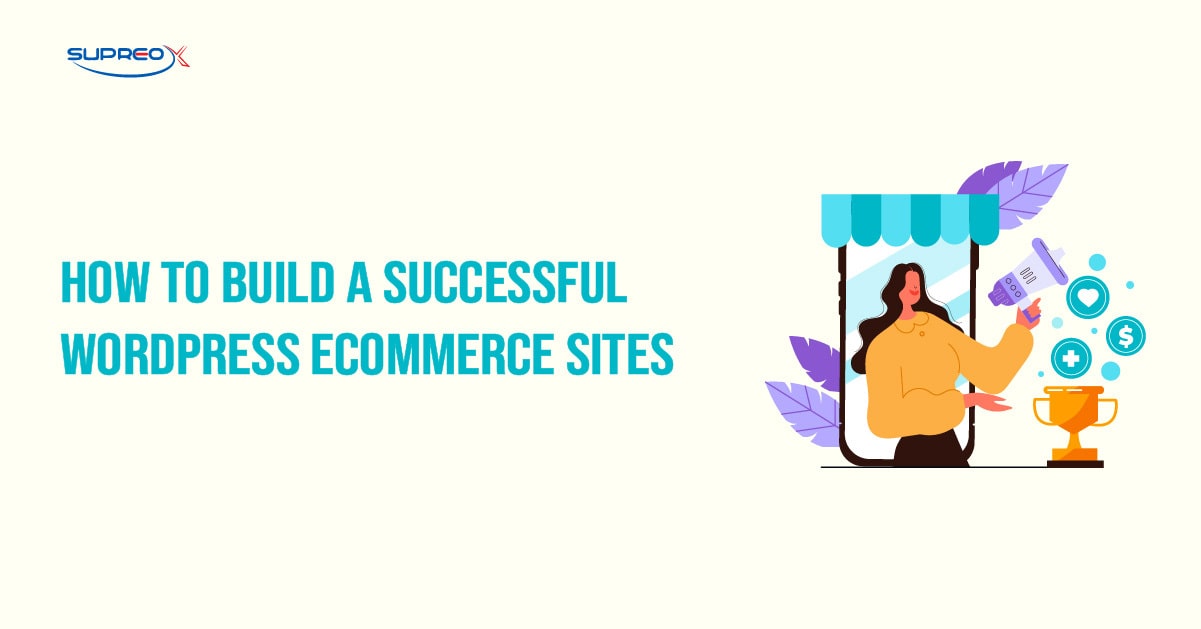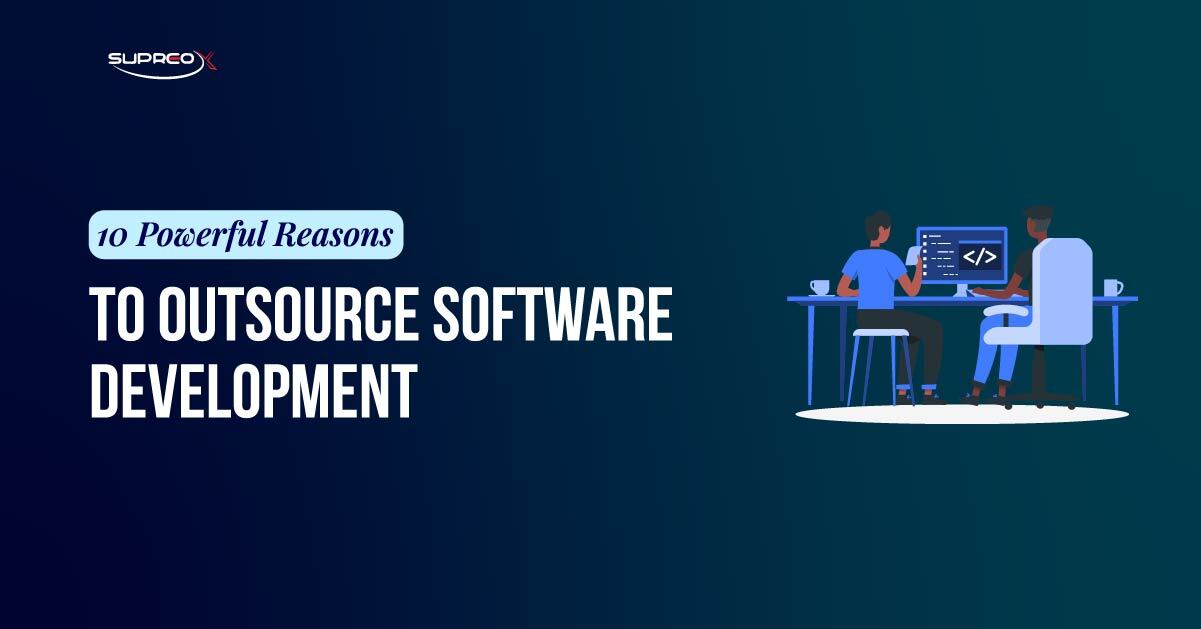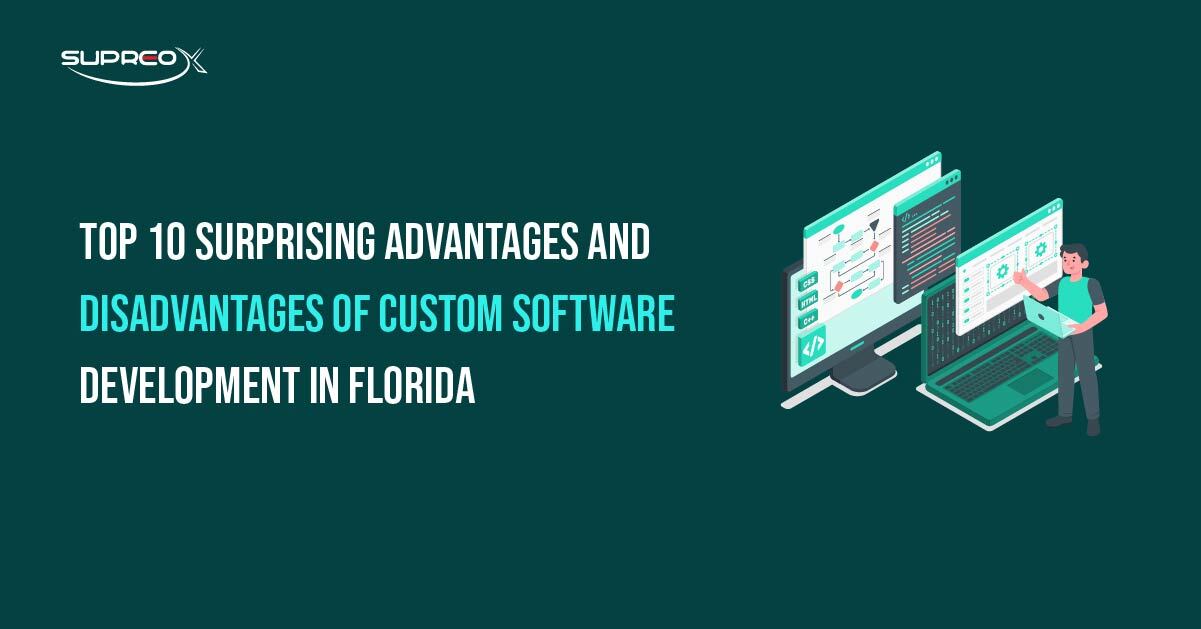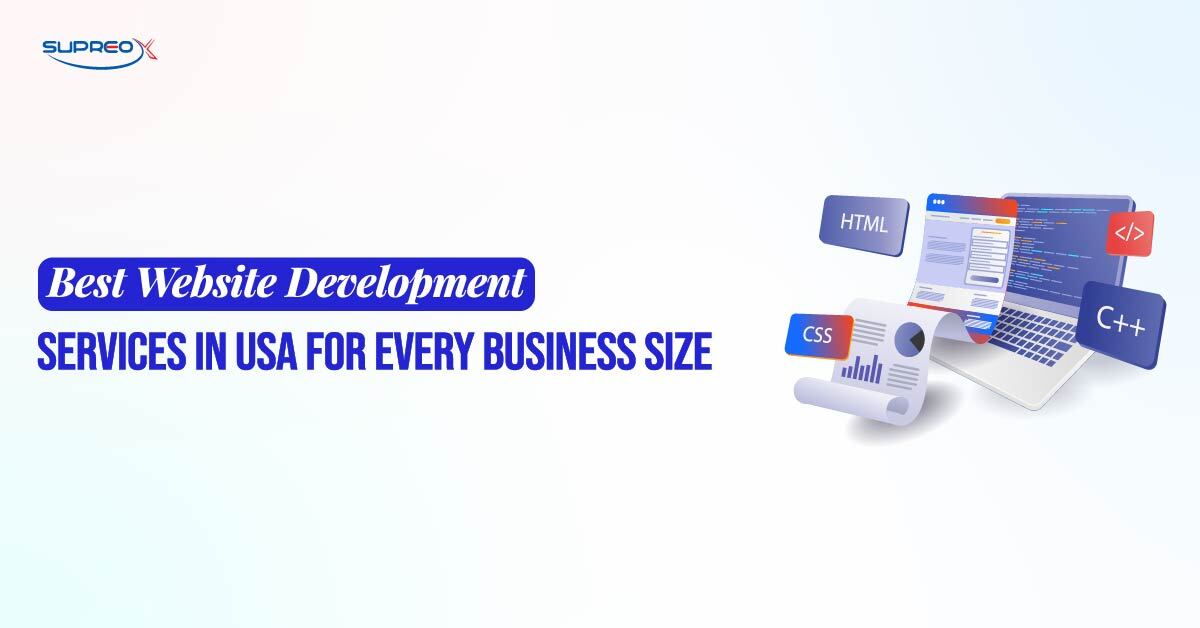If you know all the fundamentals of e-commerce or electronic commerce, becoming successful in the e-commerce business becomes easier. But if you are looking for a guide or ideas to be successful in the e-commerce business or scale up your existing store, this article is for you.
What is an E-Commerce Business?
An e-commerce business is an online store where people buy and sell products or services. Unlike regular stores, e-commerce is open 24/7, making it easy for customers and great for sellers. Global e-commerce sales are expected to reach $8.1 trillion by 2026 (Statista), proving online shopping is more relevant than ever.
E-Commerce gives access to a huge market. 79% of consumers shop online at least once a month (Forrester). So, if you plan to start an e-commerce business in 2025, go for the execution now. What would be the key consideration for starting an e-commerce business in 2025? It’s cheaper because there’s no need for a physical shop. You can pick anything from popular options for e-commerce businesses, such as dropshipping and selling digital products.
How to Be Successful in E-Commerce Business?
The number of people shopping online is growing fast. You should look for the digital marketplace to grow your business significantly. With strong determination and the right plan and tools, you can crack the code to become successful in the e-commerce business.
An e-commerce business works best when it provides customers what they need with an easy and smooth shopping experience. A 1-second delay in page load can cause a 7% drop in conversions (Google). A clear website, fast checkout, and secure payments make shopping simple. Good customer service and reliable delivery keep shoppers coming back.
Strategies for E-Commerce Success in 2025
Successful e-commerce businesses focus on solving problems for their customers. They offer convenience, competitive pricing, and excellent customer service. These businesses understand their audience and work hard to meet their expectations. Their success lies in creating a seamless shopping experience from start to finish. To succeed in the e-commerce business, you need to prioritize the following:
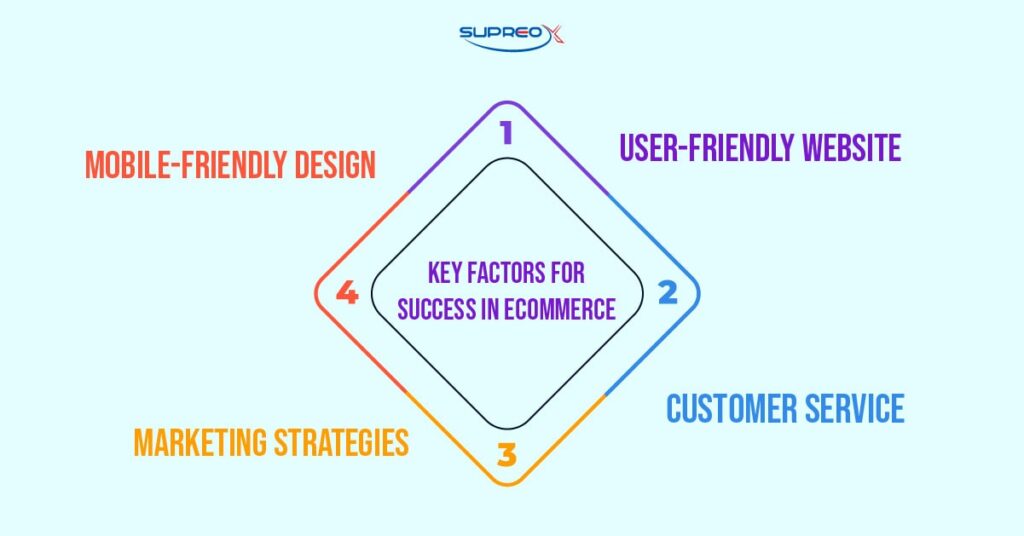
A User-Friendly Website
48% of consumers judge a business’s credibility by its website (Forrester). Your website should be easy to navigate. Custom WordPress Development or Shopify can make it simpler.
Strong Marketing Strategies
Use Search Engine Optimization, Social media, email marketing, and content marketing channels to grow your audience.
Mobile-Friendly Design
Ensure your site works well on smartphones. Mobile e-commerce sales will make up 44% of total e-commerce sales by 2025 (Statista)
Reliable Customer Service
Respond quickly to questions and resolve issues promptly because 88% of consumers won’t return to a website after a bad experience (HubSpot).
According to Statista, global e-commerce revenue could reach $1.3 trillion by 2025. With the rise of mobile shopping and improved internet access, e-commerce is becoming the preferred way for many consumers to shop.
Choose the Right Niche and Name
The most profitable e-commerce niches in 2025 include sustainable products, health and fitness, and tech accessories (Forbes). Choose the right niche and name to succeed in the e-commerce business. Focus on products with demand and create a memorable, easy-to-recognize brand name.
Pick a Profitable Category
Firstly, choose the right category. Look for products with high demand and low competition. Use tools like Google Trends or Semrush to identify trending categories. Some Popular niches are eco-friendly products, fitness equipment, and tech accessories.
Great E-Commerce Business Name Ideas
A great business name is memorable, relevant, and easy to spell. It should reflect your brand and appeal to your audience. For example, if you sell eco-friendly products, names like “Green Market” or “EcoCart” can work well. Use tools like the “Shopify Name Generator“ to brainstorm ideas.
Build a Strong Brand Identity
Your brand identity is how customers see and remember you. It includes your logo, color scheme, tagline, and messaging. A strong brand identity builds trust and makes your business stand out. Ensure your branding is consistent across your website, social media, and marketing campaigns.
Set Up Your Online Store
To build up your online store, choose a platform, create an easy-to-use website, add your products, and set up safe ways for customers to pay.
- Shopify is great for beginners because it has easy-to-use templates and is used by 28% of global e-commerce websites (Statista).
- 23% of online stores use WooCommerce, a WordPress plugin that offers more control for those who want to customize their store.
- BigCommerce works well for growing businesses and helps as your store gets bigger. These platforms help you easily manage inventory, handle payments, and design your website.
To start an e-commerce business, you must pick a product, create a website, list your items, and use marketing to attract customers and grow your sales.
- Choose a domain name: This is your website’s address. Pick something simple and related to your brand.
- Select a hosting provider: Platforms like Shopify include hosting, while WooCommerce requires a separate host.
- Design your site: Use clean, mobile-friendly templates. Consider our UI/UX design services for a professional look.
- Add products: Include high-quality photos, detailed descriptions, and competitive prices.
- Set up payment methods: Enable options like credit cards, PayPal, and digital wallets.
Key Feature to Attract Customers
To attract and keep customers, an e-commerce store must provide a smooth and enjoyable shopping experience. Here are the key features every store should have:
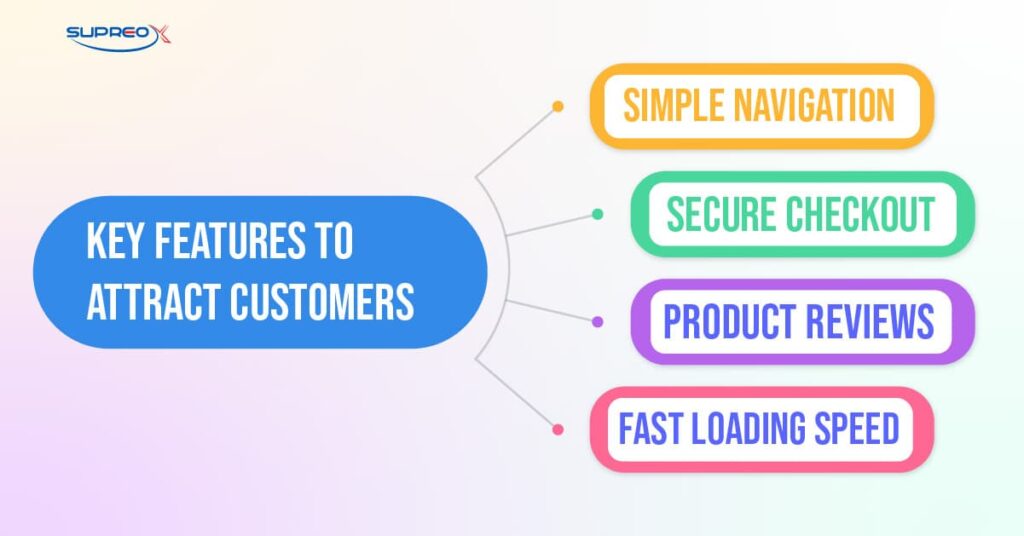
Simple navigation: Help users find what they’re looking for easily.
Secure checkout: Protect customer data with SSL certificates.
Product reviews: Build trust by showing real feedback.
Fast loading speed: Ensure your site loads quickly to avoid losing visitors. Remember that low sites lose 53% of mobile users (Google).
Smart Marketing to Grow E-Commerce Business
Smart marketing helps your e-commerce business grow by using social media, email campaigns, content creation, and ads to reach and engage more customers.
Social Media Marketing
Social media platforms like Facebook, Instagram, and Pinterest are great for promoting your products. 74% of consumers use social media to make purchase decisions (Sprout Social). Post high-quality images, videos, and engaging captions. Run ads targeting specific demographics to reach your ideal customers. Use social media analytics tools to track what’s working and adjust your strategy.
Email Marketing
Every $1 spent on email marketing generates an average ROI of $42 (DMA). Abandoned cart emails recover 10-30% of lost sales (Baymard Institute). So, grab the opportunity to make sure you are on the run.
Content Marketing
Content marketing helps drive traffic to your store. Write blogs, create how-to guides, or share product tutorials. For example, if you sell kitchen gadgets, create videos showing how to use them. Use keywords like “E-Commerce marketing strategies” to optimize your content for search engines.
Affiliate Marketing
Affiliate marketing allows others to promote your products for a commission. This expands your reach and drives sales without additional marketing efforts. Influencers and affiliates drove 20% of U.S. e-commerce revenue during Cyber Monday 2024. Tools like Refersion or ShareASale can help you manage affiliate programs easily.
Grow Your E-Commerce Business Over Time
A business plan helps you stay focused. Include your goals, target audience, budget, and marketing strategies. Update it as your business grows. Tools like Google Analytics and Semrush show how visitors interact with your site. Use this data to improve your product pages, marketing campaigns, and overall user experience.
Keep track of stock levels to avoid running out of popular items. Partner with reliable shipping services for fast and affordable delivery. This builds trust and encourages repeat purchases. Also, focus on customer retention because a 5% increase boosts profits by 25-95% (Bain & Co.). Implement loyalty programs and personalized offers.
Solve Problems and Beat Competitors
If your e-commerce business faces challenges, to run a successful ecommerce business, solve the below issues:
- Slow website speed.
- High cart abandonment rates.
- Handling customer complaints.
69.8% of shoppers abandon carts (Baymard Institute), 48% leave due to unexpected costs (shipping, taxes), and 26% abandon due to complicated checkouts. Solve these issues by regularly updating your site, simplifying processes, and responding to customer feedback. Analyze your competitors using tools like Ahrefs or Competitor Analysis Tools. Offer better prices, unique products, or faster delivery to stay ahead of competitors.
How to Solve E-commerce Problems and Beat Competitors in 2025?
The e-commerce market is changing rapidly. To make your e-commerce business successful, stay flexible and adapt to trends like voice search, AI tools, or new social media platforms.
Keep Customers Happy
Making your customers happy is one of the most important ways to grow your online store. Give fast help, rewards, and good service. Stay updated on trends to keep them coming back and trusting your business. To keep your customers happy, you can use:
Chatbots for Quick Help
Chatbots answer common questions 24/7, saving time for you and your customers. They’re cost-effective and improve customer satisfaction.
Build Customer Loyalty
Offer loyalty programs, exclusive discounts, and rewards for repeat customers to keep them coming back to your store.
Collect Reviews and Feedback
Encourage satisfied customers to leave reviews. Positive feedback builds trust and attracts new buyers.
AI and Automation for Efficiency
AI tools help analyze data and predict customer trends. Automation saves time by handling tasks like email campaigns and inventory updates.
Stay Updated on E-Commerce Trends
Follow e-commerce news and updates to keep your business competitive. Trends like AR (Augmented Reality) and voice search are becoming popular in online shopping.
E-Commerce Trends to Watch in 2025
Starting and scaling your e-commerce business in 2025 will require smart planning and continuous improvement. Otherwise, it will be difficult to stay competitive. Be prepared for:
Voice Search
By 2025, 50% of all online searches will be voice-based (ComScore). With the rise of smart assistants like Alexa, Siri, and Google Assistant, consumers are shifting towards hands-free searches. E-commerce businesses must optimize product listings with conversational keywords and structured data to ensure they rank well in voice search queries.
AI & Automation
AI-driven chatbots handle 85% of customer service interactions (Juniper Research). AI chatbots can provide instant, 24/7 responses to customer queries, improving satisfaction and reducing support costs. Additionally, automation tools can streamline order processing, inventory management, and personalized marketing campaigns, creating a more efficient and customer-friendly shopping experience.
Augmented Reality (AR)
AR technology allows customers to try products virtually before purchasing, enhancing confidence and reducing return rates. Businesses in the fashion, furniture, and beauty industries are integrating AR to offer interactive experiences that simulate in-store shopping, making online purchases more engaging and informed. AR-driven shopping experiences increase conversions by 40% (Deloitte).
Conclusion
Starting and growing an online store takes time and hard work. Pick the right products, create an easy-to-use store, and use smart marketing. Keep improving and follow new trends. With steady effort, your e-commerce business can succeed.
Discuss your ideas with SupreoX to get the best result for your business category. Our expert team members can suggest and work alongside you to make your e-commerce business successful.
FAQs
How do I choose the best category for my e-commerce business?
Using tools like Google Trends and Semrush, pick products with high demand and low competition. Choose a niche you understand and enjoy.
What features does a successful e-commerce website need?
Your site needs simple navigation, fast loading, secure payment options, and product reviews to build trust and enhance the shopping experience.
How can content marketing help my store?
Content marketing drives traffic, builds trust, and improves Search engine optimization. Share helpful blogs or videos to engage customers and promote your products.
What tools can help me analyze competitors?
Tools like Ahrefs and Semrush help analyze competitors’ keywords, traffic, and strategies. They provide insights to improve and stay ahead.
How can chatbots improve my store?
Chatbots provide instant answers 24/7. It improves customer satisfaction and makes shopping easier, which leads to more sales.
What are the most common mistakes in the e-commerce business?
Avoid slow websites, poor customer service, and ignoring market research. These issues frustrate customers and hurt your sales.

